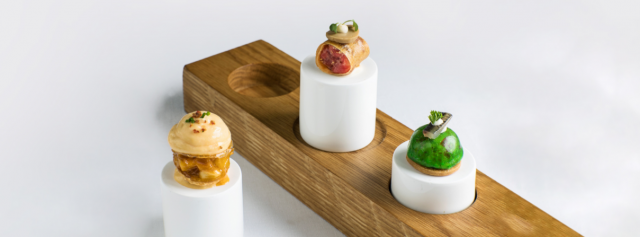 ©Restaurante Cenador de Amós
©Restaurante Cenador de Amós
Cantabria, the cool, verdant region and autonomous community astride the Bay of Biscay in north Spain has long been a favourite getaway of Spaniards and some foreign visitors for its lovely natural, cultural, and historical allures. And increasingly, discerning foodies also know it as something of a culinary mecca, with superb local ingredients transmogrified into a tempting menu not just of traditional local cookery but also some of the world’s highest rated fine-dining restaurants. For example, Cantabria boasts six Michelin-starred restaurants (with nine stars between them) which fuse tradition and cutting edge to create masterful modern dishes steeped in local roots – one in regional capital Santander and the rest within an hour’s drive or less; it’s also worth noting that several of these are also surprisingly accessibly priced for a dining experience of this calibre. So today I’m offering a quick taste of each.
 ©Restaurante El Serbal
©Restaurante El Serbal
El Serbal, Santander
We start out in Santander‘s centrally located Puertochico neighbourhood. Founded in 1999, El Serbal received its Michelin star just four years later, and since then has kept going strong under dedicated chef Quique Muñoz y sommelier/maître d’ Rafael Prieto.
Presented in a cosy, welcoming dining room with warm colours, subdued lighting, and a décor mixing classic and modern, El Serbal’s meticulously curated menu of nouvel Cantabrian cuisine offers something for nearly everyone. House specialities include steak tartare and flambées, whereas if you’re in the mood for something more avant-garde, you’ll find Quique’s creativity in full flight with dishes such as tartar de vieiras y gambas (scallops and shrimp tartare in an emulsion of barbel, a small, carplike freshwater fish); charcoal-fried presa ibérica (an exquisite, intensely flavoured cut of pork shoulder) with cream of carrot confit in coffee oil; and ravioli de cocido con su crema y puré de garbanzos (stew ravioli in cream and chickpea purée). There’s also the option of three tasting menus, one of them including vintage 2009 Dom Pérignon Champagne.
Add to this the impeccable service and attention to detail; artesan breads fresh out of the oven; a selection of scrumptious Cantabrian cheeses; a list of more than 500 superb Spanish and international wines; and it add up to the fact that El Serbal should sit firmly on the bucket list of any visiting foodie.
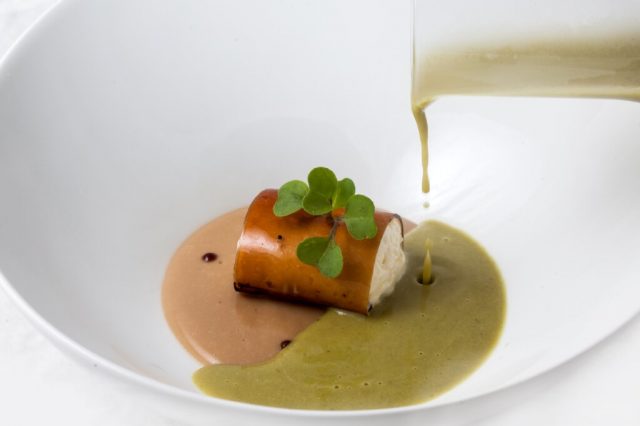 ©Restaurante Solana
©Restaurante Solana
Solana, Ampuero
In this lovely small town of nestled in a mountain valley about 45 minutes’ drive east of Santander, the main lures include its own annual running of the bulls in early September; the 17th-century Baroque Sanctuary of the Bien Aparecida, tthe madonna that is Cantabria’s patron saint; and salmon and trout fishing on this area’s stretch of the Asón River. It’s this last which plays into another Ampuero claim to fame: truly excellent eating. And right across from the sanctuary is this restaurant helmed by 31-year-old Ignacio Solana, a fourth-generation hospitality veteran (it was founded by his great grandparents in 1938) who has made himself one of Spain’s youngest Michelin-starred chefs by leveraging the local bounty into an extraordinary culinary experience centred around reinventing the region’s hearty traditional guisos (stews and casseroles with a variety of ingredients) – using, of course, only the freshest seasonal raw materials.
Standouts on Solana’s menu includes a nouvel version of Cantabria’s classic cocido montañés, a rich and robust stew of pork, bacon, sausage, white beans, and collard greens; Gillardeau oysters with gazpachuelo, en eggy/garlicky potato soup; cheesecake that’s a deconstructed version of this region’s reknowned quesada; and a nouvelle take on Spain’s ubiquitous ham croquettes that in 2017 won acclaim as “the world’s best croquettes” at the prestigious avant-garde gastronomy event Madrid Fusión. Here, too, there’s a tasting menu, and the wine list includes more than 450 vintages.
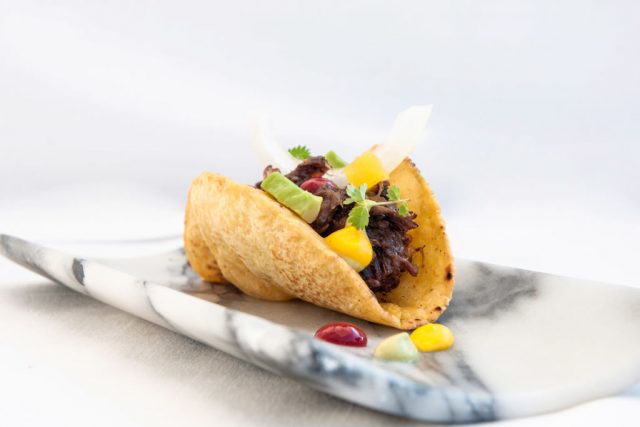 ©Restaurante El Nuevo Molino
©Restaurante El Nuevo Molino
El Nuevo Molino, Puente Arce
Even closer to Santander – just a 15-minute drive southwest – “The New Mill” is actually housed in an old mill built of stone on the Pas River, dating back to the 18th-century, alongside a traditional Cantabrian farmhouse, the reincarnation of El Molino, whose illustrious chef Victor Merino helped launch Spain’s nouvelle cuisine movement in the latte 1970s. After Merino died in an auto accident, chef Toni González, with the help of Rafael Prieto and others from Santander’s El Serbal, launched this worthy successor in 2004, and earning its own Michelin star four years later.
And amidst classic rustic ambiance, overlooking an impressive garden (all a romantic setting especially popular for weddings), contemporary but very much locally rooted farm-to-table treats such as rabas de calamar sobre espuma de ali oli de tinta (crispy calamari over squid-ink aïoli); several dishes involving succulent beef from Cantabria’s prized Tudanca breed of cattle, such as Tudanca beef carpaccio on a cornmeal cake with cheese and summer truffles; and caramelised French toast with ginger ice cream. Apart from a tasting menu and more than 300-label wine list, other perks here include warm-weather dining on a garden terrace; a chapel converted into a “Hennessey space” specialising in fine spirits as well as Cuban cigars.
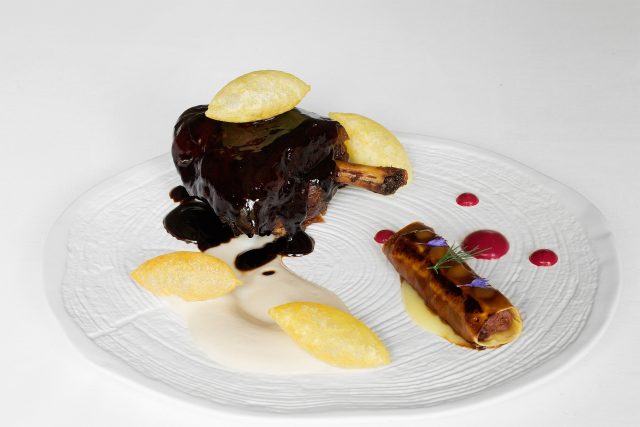 ©Restaurante La Bicicleta
©Restaurante La Bicicleta
La Bicicleta, Hoznayo
Nine years ago, Eduardo Quintana and Cristina Cruz set up “The Bicicyle” in an 18th-century stone house in their small home town a little over 20 minutes southeast of Santander, then relaunched in 2016 as a fine-dining establishment with vintage-chic décor and what they call a “clean cuisine, emotional and visual, of subtle flavours, with roots in traditional gastronomy,” based on local and seasonal ingredients, which won it a Michelin star within a year.
Key examples from Bicicleta’s menu: ravioli de cabrito en sopa de caricos (kid-goat ravioli in red-bean soup); scallops bathed in broth made from cocido lebaniego, another very characteristic Cantabrian stew; and various top-quality meat dishes. Edu and Cris also run a pop-up offshoot, dubbed La Pizzicleta, specialising in gourmet pizzas made with organic wheat flour as well as Cantabrian cheeses and other local ingredients. The wide-ranging wine list includes a number of local vintages little known outside Cantabria.
 ©Restaurante Annua
©Restaurante Annua
Annua, San Vicente de la Barquera
With an indoor-outdoor location breezily perched on the edge of the sea in a historic, picturesque, and still very much working fishing village on the coast, two-star Annua takes a multicultural fusion approach to creating culinary masterpieces with Cantabrian raw material. Its 39-year-old chef Óscar Calleja combines local culinary traditions with those of Mexico (where he spent his boyhood) and Asia (reflecting his extensive later travels throughout that continent), in addition to specialising on San Vicente’s prized local oysters. Standouts on Calleja and his kitchen team’s tasting menus – artistically presented to a fault – include aguachile de ventresca y mango (chile-pepper broth with tuna belly and mango); Tudanca beef with broccoli mole and parmesan; and a very light, minimalist “stew” of pine nuts, eel, and fresh cheese. This talented chef works hard to innovate, and it certainly shows.
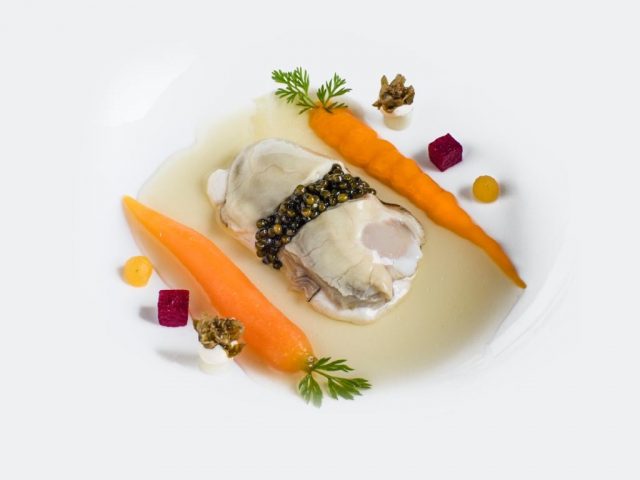 ©Restaurante Cenador de Amós
©Restaurante Cenador de Amós
Cenador de Amós, Villaverde de Pontones
Last but certainly not least comes the oldest and most Michelin-acclaimed (three stars, as of Michelin’s 2020 edition) on this list, run by internationally acclaimed celebrity chef Jesús Sánchez and his wife Marian Martínez since 1993 in another village (and a tiny one, with barely 350 souls) packed with historic architecture – one example of which is this temple of gastronomy, housed amidst lovely natural surroundings in the Baroque Mazarrasa Palace, dating back to 1756 and furnished in a mix of classic, rustic, and minimalist-modern. So even before you sit down to eat, as the owners point out, “the experience begins the moment guests enter the restaurant”.
Jesús, too, is a virtuoso at taking traditional Cantabrian ingredients and dishes and using cutting-edge techniques to transform them into modern works of art of the highest order. The Cenador’s two tasting menus are comprised of seasonally changing dishes on the order of perfecto de foie sobre bizcocho de aceituna negra (a wedge of cream of foie gras mounted on a think layer of black-olive cake and crowned with a crust of caramelised sugar, macadamia nuts, and passionfruit); smoked, charcoil-broiled cuttlefish with cuttlefish ink and marine vegetables); and tronco de cigala con tuétano y caviar (lobster filet with marrow and caviar). The more than 200-year-old wine cellar, overseen by sommelier Andrés Rodríguez, holds nearly 500 vintages, and there’s a dedicated bread oven.
So as you can see, Cantabria has truly become a culinary hot spot of excellence, driven by brilliant talents who pour their hearts, souls, and creativity into showcasing this wonderful region in the manner it so richly deserves. And for more on Cantabria’s culinary side, check out the above video from Iberia Mayor Carlos Maldonado, which includes visits to El Serbal and Solana. It’s in Spanish only, but you’ll definitely get the gist.
Delicioso!

